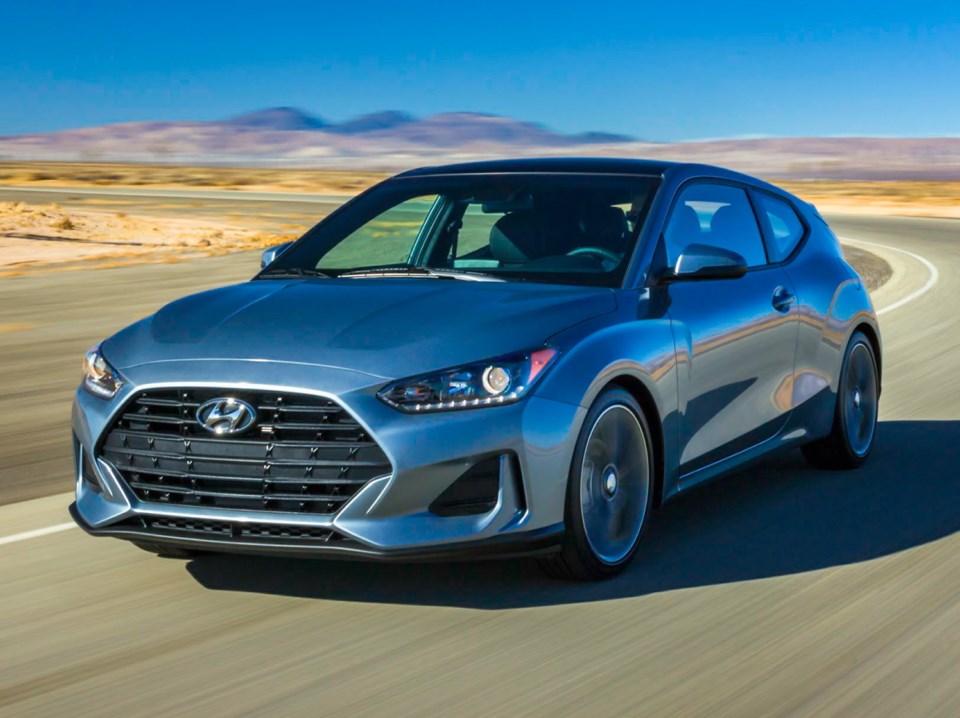Leaving well enough alone is rarely a good idea in the automotive business, but automakers also risk losing their customer base for their more popular models if they get too carried away. The 2019 Veloster, which Hyundai identifies as a youth-oriented model, deftly straddles the line between old and new with familiar styling that masks significant changes below the sheetmetal.
Legions of Veloster-ites will recognize the new nose, replete with de rigueur mesh grille, sculpted hood and muscular fenders. Other visible changes include restyled rear roof pillars and a more upright hatchback that helps increase stowage space, with the rear seat in place, by nearly 30 per cent. With the rear seat folded, a now nearly flat load floor should also yield a bit more cargo room.
The passenger compartment is attractive enough, but the businesslike dashboard and control panel are no match for the previous Veloster’s more stylized appearance.
Carried over is the Veloster’s signature passenger-side third-door. It’s small, which makes it harder for adult-sized riders to access the rear seat, but it’s still easier than entering though the driver’s side of the car.
Most of the new Veloster’s key dimensions — length, width, height and distance between the front and rear wheels — vary only slightly from the previous model.
What has changed is the car’s platform that was originally borrowed from the subcompact Accent. The Veloster now uses the architecture developed for the Elantra sedan. A multi-link independent rear suspension is standard and provides superior ride and road-holding qualities compared with the previous torsion-beam (solid) rear axle.
For 2019, the base engine’s displacement has been increased to 2.0 litres from 1.6, with a corresponding increase in output to 147 horsepower and 132 pound-feet of torque (from 132/120).
Returning is a turbocharged 1.6-litre four-cylinder with 201 horsepower and 195 pound-feet. Although those numbers are unchanged, peak torque output is now attained at 1,500 rpm versus the previous 1,750 rpm.
The 2.0 connects to a six-speed manual transmission or available six-speed automatic, while the turbo 1.6 can also be had with a six-speed stick. A seven-speed paddle-shift automatic is an extra-cost option.
With either engine comes driver-controlled Normal, Sport and Smart (eco) drive modes.
Top fuel economy is a virtual tie between the six-speed automatic 2.0 and the seven-speed automated-manual turbo 1.6 (the 2.0 is rated at 9.4 l/km in the city and 7.1 on the highway).
For big-time performance in a compact package, Hyundai will roll out the Veloster N performance model late this year. This iteration’s turbocharged 2.0-litre four-cylinder powerplant delivers “up to” 275 horsepower and 260 pound-feet of torque. It’s mated to a tougher six-speed manual gearbox that has rev-matching downshifts. A rear high-mount spoiler, aero body cladding, electronically controlled dampers, sport bucket seats and sport exhaust system are also part of the N package.
While there’s no word as to the Veloster N’s pricing, the base 2.0 is $22,700, including destination charges. That gets you the usual accoutrement plus blind-spot detection with cross-traffic backup alert.
The 2.0 Turbo adds a premium interior, panoramic sunroof, LED headlights and taillights and push-button ignition.
The top-end Turbo Tech gets leather seating surfaces, navigation system, head-up information display (which projects vital stats such as speed onto the windscreen), navigation system and rear-parking-assist sensors. There’s no active-safety technology available in any model.
The Veloster was a genuine oddity when it first arrived for the 2012 model year, but its non-conformist styling has certainly attracted younger buyers seeking high style at an affordable price. Fast-forward to this year, and Hyundai’s mission remains unaltered, even though the car itself has evolved and matured.



